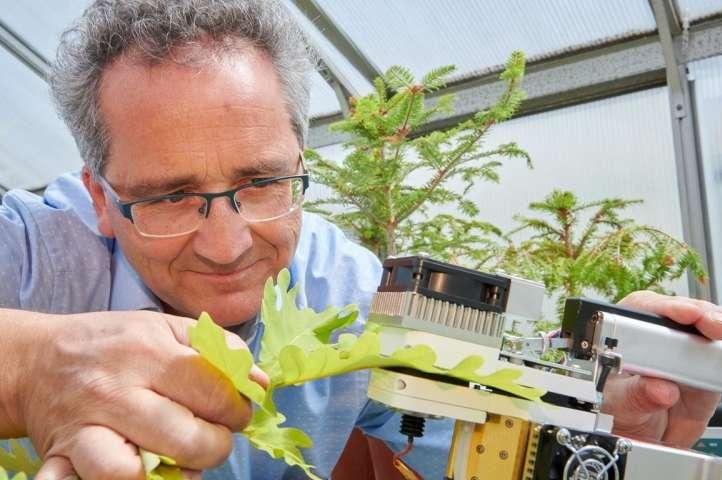Researcher Juergen Burkhardt looks at a leaf's pores under a microscope. Photo by Volker Lannert/Uni Bonn
July 16 (UPI) -- Pollution is bad for trees, too. According to a new study, particulate matter in the air can make trees more vulnerable to drought.
Research showed particulate matter caused leaves to transpire, which could exasperate the ill effects of a drought. Several recent surveys suggest prolonged droughts are taking their toll on tree health around the world.
Most recently, hot, dry conditions were blamed on the deaths of several of Africa's oldest baobab trees.
"There have been different explanations for these regional events, but a comprehensive explanation is still missing," Juergen Burkhardt, researcher at Bonn University's Institute of Crop Science and Resource Conservation in Germany, said in a news release.
Stomata, the pores on the leaves of plants, allows in carbon dioxide, which is essential to photosynthesis. Without enough CO2, the plant can't convert sunlight into food and it will starve. But the opening of the plant's leaf pores also allows water vapor to be released into the air. The transpiration process allows plants to stay cool, but during drought conditions, plants need all the water they can get.
Sometimes, plants are forced to balance the risks of starvation against the risks of dehydration. Over millions of years, plants have evolved to master this balancing act.
"Plants have adapted stomatal regulation to prevailing ambient conditions over evolutionary timescales, but particulate matter concentrations were generally much lower than they are today," Burkhardt said.
In the lab, scientists exposed Scots pine, silver fir and common oak seedlings to different air and moisture conditions. Trees exposed to clean, filtered air allowed less water vapor to escape than those exposed to polluted air from the city. All of the trees had the same stomata structure -- their pores were closed.
"The deposition of particulate matter increases foliar transpiration," Burkhardt said. "These experiments point to a direct, but so far missing, link between air pollution and drought vulnerability."
Scientists detailed the missing link this week in the journal Environmental Research Letters.
In the newly published paper, scientists argue particulate matter encourages transpiration by triggering condensation.
"These are tiny amounts of water, however, invisible to the naked eye," said Burkhardt. "And rather than being pure water, they are highly concentrated salt solutions."
Burkhardt and his colleagues believe these tiny salt solutions are able to penetrate closed stomata, forging a link between the air and the insides of a trees' leaves. These wick-like links pull water out of the leaves.
When the tiny salt solutions evaporate, they leave behind salty crusts. In the lab experiments, researchers were able to identify the salty signatures on the leaves of trees exposed to air featuring high concentrations of particulate matter.
"Such crusts have been observed on damaged trees in the past, and the phenomenon was then named wax degradation, but its origin has remained elusive," said Burkhardt. "Particulate matter, which is usually imagined as small granules, has not been considered a contributing factor."















